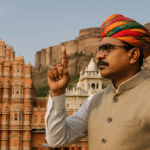New Delhi – In an era where information is just a click away, one would assume greater clarity on matters of faith and belief. However, the reality is far from it. The digital age has brought with it not just a wealth of knowledge but also an avalanche of misinformation, half-truths, and sensationalist narratives. The question arises: In the age of information, are we closer to understanding faith, or are we more confused than ever before?
The Information Explosion: Blessing or Curse?
The internet, with its billions of websites and endless social media feeds, has democratized access to religious knowledge. But this democratization has come at a cost.
- The Rise of ‘Digital Gurus’
- Online spiritual leaders and influencers have flourished, offering simplified versions of religious doctrines. While this has made spirituality more accessible, it has also led to oversimplification and, at times, distortion.
- A 2022 Pew Research Center study found that over 60% of young Indians turn to YouTube or Instagram for spiritual guidance rather than traditional religious institutions, raising questions about the authenticity of their sources.
- The Misinformation Epidemic
- Fake narratives cloaked in religious rhetoric are rife on platforms like Facebook and WhatsApp. From manipulated religious quotes to fabricated stories about interfaith conflicts, such content often fans communal tensions.
- For instance, a 2023 report by IndiaSpend revealed that over 70% of fact-checked fake news stories in India had a communal angle, highlighting how misinformation disproportionately targets religious beliefs.
Faith Under the Spotlight
The constant scrutiny and reinterpretation of religious texts in the digital age have made faith a battleground for opinions rather than a sanctuary for introspection.
- Selective Interpretations
- Social media has allowed individuals to cherry-pick religious teachings, often taking them out of context to serve their agendas.
- For example, debates on gender roles in religious spaces surged online after the 2023 Sabarimala Temple verdict, with both supporters and detractors quoting scripture to back their views.
- Rise of Performative Piety
- The digital age has also led to what some critics call “performative faith,” where acts of devotion are showcased online for likes and validation. From live-streamed pujas to hashtag-driven pilgrimages (#BlessedAtVaranasi), faith is increasingly becoming a spectacle.
Conflicting Narratives and Generational Divides
The abundance of information has created significant generational rifts in how faith is perceived and practiced.
- Millennials and Gen Z
- Younger generations often challenge traditional practices, turning to podcasts, blogs, and digital platforms for answers. They demand explanations rooted in logic, inclusivity, and environmental consciousness.
- A 2021 YouGov India survey found that over 50% of urban Indian youth consider themselves “spiritual but not religious,” reflecting a shift in how they approach faith.
- Traditionalists’ Resistance
- Elders, who rely on established religious institutions, often view these digital interpretations as a dilution of sacred traditions. This generational divide fuels debates on what constitutes “true” faith in the modern age.
The Role of Media: Amplifier or Agitator?
The media, particularly social media, plays a dual role in shaping faith in the digital era.
- Amplifying Positivity
- Campaigns like eco-friendly Ganesh idols or interfaith blood donation drives highlight how digital platforms can be harnessed for communal harmony and progressive initiatives.
- Agitating Divisions
- However, the same platforms also amplify divisive voices. A 2023 study by the Internet Freedom Foundation found that 40% of hate speech incidents reported online had religious undertones, underscoring the internet’s darker side.
Charting a Path Forward
In a world overflowing with information, the need for discernment has never been greater. To reconcile faith with the digital age, several steps are essential:
- Promoting Media Literacy
- Schools and institutions must educate individuals on identifying misinformation, encouraging critical evaluation of online content.
- Encouraging Offline Reflection
- Faith leaders should promote introspection and dialogue over digital consumption, encouraging followers to engage with beliefs in a meaningful, offline manner.
- Regulating Digital Content
- Platforms must take stronger action against religious misinformation, investing in fact-checking mechanisms and promoting verified sources.
Conclusion: A Crossroads of Faith and Information
Faith, once a deeply personal journey, is now increasingly mediated by digital platforms. While the internet has democratized access to religious knowledge, it has also muddied the waters with conflicting narratives and sensationalist rhetoric.
The challenge for India lies in navigating this information age responsibly—balancing the richness of tradition with the realities of modernity. The question remains: Can we sift through the noise to rediscover the essence of faith, or will we let the confusion consume us?







